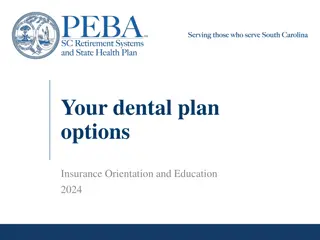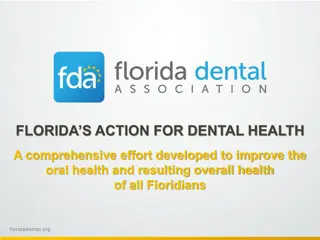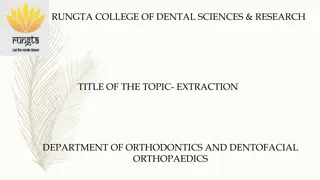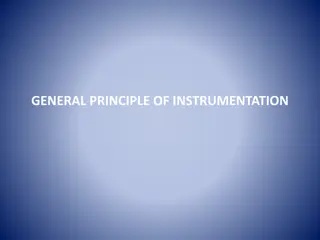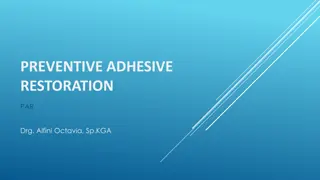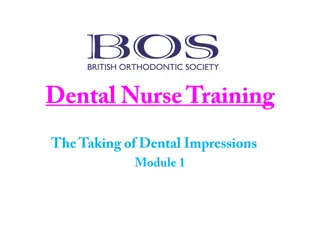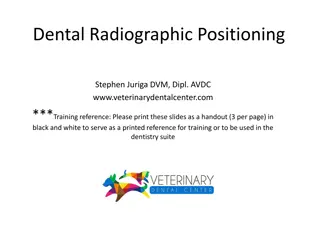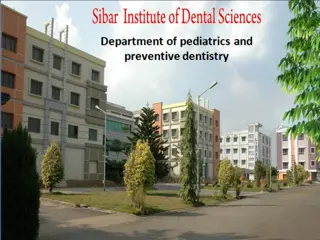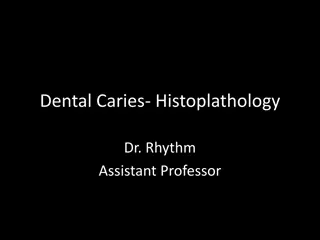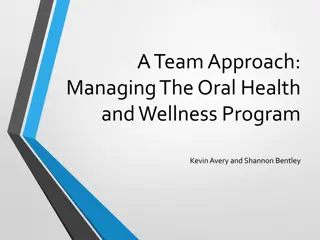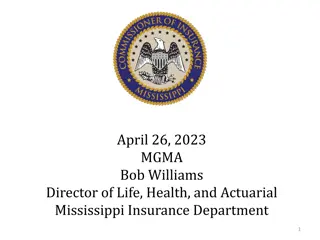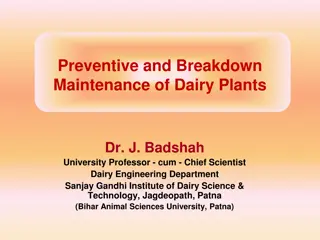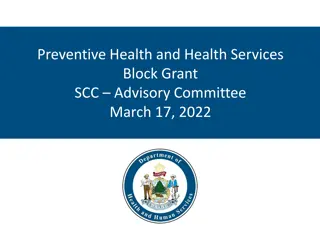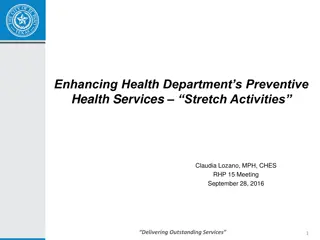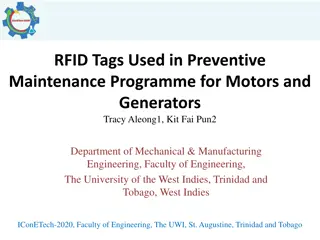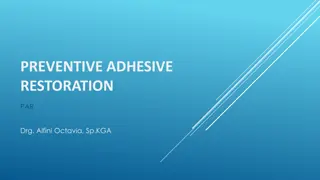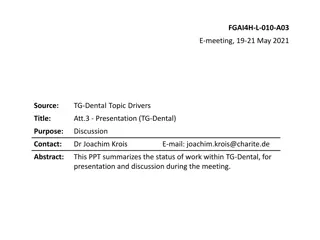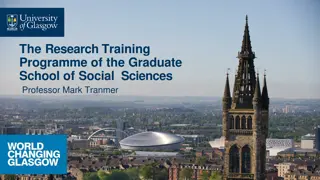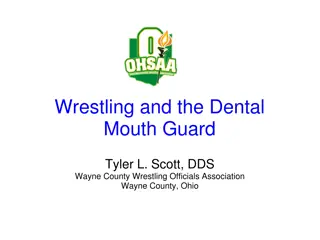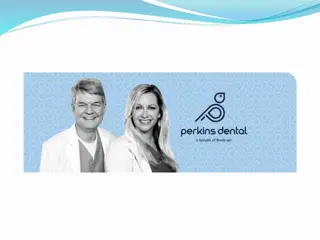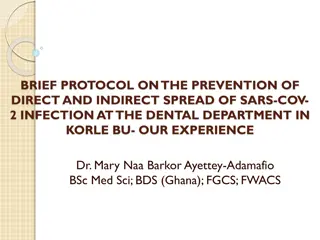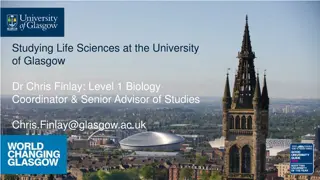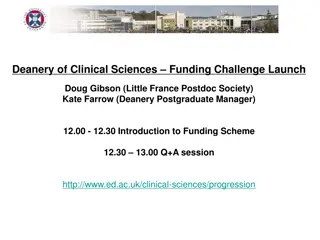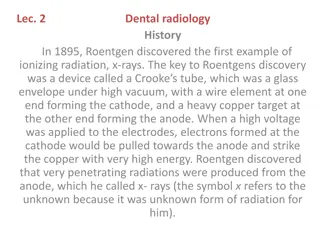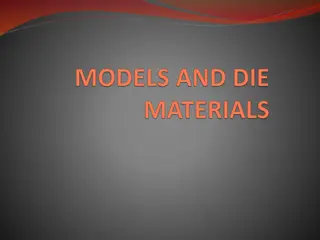Preventive Orthodontics in Dental Sciences Research
Preventive orthodontics in the Department of Orthodontics and Dentofacial Orthopedics involves educating patients and parents, controlling caries, managing deciduous dentition, and more to preserve normal occlusion. Procedures include patient education, caries control, and care of deciduous dentition among others. This practice aims to supervise dentition growth and predict malocclusion, taking action to maintain dental integrity.
Download Presentation

Please find below an Image/Link to download the presentation.
The content on the website is provided AS IS for your information and personal use only. It may not be sold, licensed, or shared on other websites without obtaining consent from the author. Download presentation by click this link. If you encounter any issues during the download, it is possible that the publisher has removed the file from their server.
E N D
Presentation Transcript
RUNGTA COLLEGE OF DENTAL SCIENCES & RESEARCH TITLE OF THE TOPIC- PREVENTIVE ORTHODONTICS DEPARTMENT OF ORTHODONTICS AND DENTOFACIAL ORTHOPAEDICS
Specific learning Objectives CORE AREAS Preventive Orthodontics Definition Procedures in Preventive Orthodontics DOMAIN CATEGORY AFFECTIVE DESIRE TO KNOW COGNITIVE MUST KNOW SPACE MAINTENANCE PSYCHOMOTOR MUST KNOW INDICATIONS AFFECTIVE NICE TO KNOW ADVANTAGES COGNITIVE NICE TO KNOW
CONTENTS PART I Preventive Orthodontics Definition Procedures in Preventive Orthodontics 1 Patient and Parent Education 2 Caries Control 3 Care of Deciduous Dentition 4 Management of ankylosed tooth 5 Maintenance of Shedding timetable 6 Checkup for Oral habits & habit breaking appliances 7 Occlusal Equilibrium 8 Prevention of damage to Occlusion 9 Extraction of Supernumerary Teeth 10 Management of locked 1st permanent molars 11 Management of abnormal frenal attachment PART II 12 Space maintenance a. Definition b. Ideal Requirements c. Classification d. Removable space maintainers
CONTENTS (contd) e. Fixed space maintainers : Examples ~Band and loop space maintainer ~Crown and loop space maintainer ~Lingual arch space maintainer ~Palatal arch space maintainer ~Transpalatal arch space maintainer ~Distal shoe space maintainer Indications, Contraindications ~Band and bar space maintainer ~Crown and bar space maintainer ~Preformed banded space maintainer Advantages & Disadvantages of Fixed space maintainer
PreventiveOrthodontics Definition:Preventive orthodontics is that part of orthodontic practice which is concerned with the patient s and parent s education, supervision of the growth and development of the dentition and the cranio-facial structures, the diagnostic procedures undertaken to predict the appearance of malocclusion and treatment procedures Itistheactiontakentopreservetheintegrityofwhat appearstobethe normalocclusionataspecifictime (Graber-1966).
The following are some of theprocedures undertaken in preventiveorthodontics: 1) Parent & patienteducation 2) Cariescontrol 3) Careofdeciduousdentition 4) Managementofankylosedtooth 5) Maintenanceofquadrantwisetoothsheddingtimetable 6) Checkupfororalhabitsandhabitbreakingapplianceif necessary 7) Occlusalequilibriumifthereareanyocclusalprematurity 8) Preventionofdamagetoocclusion.eg:-milwaukeebraces
The following are some of the procedures undertaken in preventive orthodontics: Cont... 9) Extractionofsupernumeraryteeth 10) Spacemaintenance 11)Managementofdeeplylockedfirstpermanentmolar 12)Managementofabnormalfrenalattachments
1) Parent & patienteducation Expectingmother-Nutrition,idealenvironmentfor developingfetus,avoidcertaindrugs. Soonafterbirth-Propernursingandcareofchild. Ifbottlefed-Usephysiologicnippleandnotconventional nipple (donotpermitsucklingbymovementoftongueand lowerjaw) leadingtovariousorthodonticproblems. ConventionalNipple PhysiologicNipple ConventionalvsPhysiologicNipple
Cont 1) Parent & patient education Donotusepacifiersforalongtime. Pacifier Nursing bottlesyndrome Preventionofnursingbottlesyndrome:(Bottlefeeding duringnight-upperteethcaries.Butnolowercaries) Propernutritionofthechild&propernursingcareofthe infant. Correctmethodofbrushingteeth
2) Cariescontrol Caries in proximal surface of deciduous teeth if not restored leadsto lossofarchlengthbymovementofadjacentteethinto the space and thus cause discrepancies between arch length andtoothmaterialwhen largerpermanentteetheruptintothe oralcavity. Fig:SSCrowntopreventfurthercariesaswellaspreventionof movementofadjacentteethtomaintainarchintegrity
3) Care of deciduousdentition Preventionandtimelyrestorationofcariousteeth. Alleffortstopreventearlylossofdeciduousteeth(theyare natural spacemaintainers) Simplepreventiveprocedureslike:Applicationoftopical fluorides,Pit&fissuresealantsetc. Topicalfluorides Pit&fissuresealants
Cont 3) Care of deciduous dentition Supernumerary & supplemental teeth can interfere with eruption of nearby normal teeth. They deflect adjacent teeth and erupt in abnormal positions. They should be identified and extracted before theycausedisplacementofotherteeth. Supernumeraryteeth Supplementalteeth
4) Management of ankylosedtooth Ankylosis is a condition characterized by absence of the periodontal ligamentinsmallareaorwholeoftherootsurface. Fig: Ankylosis ofteeth Theydonotresorb preventpermanentteethfromerupting deflectthemtoeruptinabnormalpositions. Theyshouldberemovedsurgicallyatappropriatetimeto allow emergenceofthesuccessor.
5) Maintenance of quadrant wisetooth shedding timetable
5) Maintenance of quadrant wise tooth shedding time table Cont After shedding of deciduous teethit should not take more than 3 months for eruption of permanent teeth.
6) Checkup for oral habits andhabit breaking appliance ifnecessary IdentifyandstophabitssuchasThumbsucking,nailbiting, tonguethrustingandlipbiting. Prevention starts with proper nursingnippleandpacifiersto enhancenormalfunctionalanddeglutitionactivity.
7) Occlusal equilibrium if there are any occlusal prematurity Cuspal interferenceshould be removed by selective grinding of the tooth. Abnormal anatomical features like enamel pearl, may cause prematurecontact. Problem: Deviationinthemandibularpathofclosure Predisposetobruxism Dx: Detectedby using articulatingpaperandpremature contactremoved byselectivegrindingiscarriedout.
8) Prevention of damage toocclusion. PreventingMILWAUKEE Bracedamage: Orthopedicapplianceusedforcorrectionof scoliosis. Itappliestremendousforceonthemandibleandthe developing occlusion leading to retardation of mandibular growthandpossibledeformities. wheneversuchapplianceused,occlusionshouldbe protectedusing functionalapplianceorpositioners. madeofsoftmaterials.
9) Extraction of supernumerary teeth Supernumerary&supplementalteethcaninterfere with eruptionofnearbynormalteeth. Theydeflectadjacentteethanderuptinabnormal positions. Theyshouldbeidentifiedandextractedbeforethey cause displacementofotherteeth.
10) Management of deeply locked first permanent molar Occasionally the deciduous second molar have a prominentdistalbulgewhichpreventstheeruptionof the first permanent molars. Slicing these distal surface helps in guiding the eruption of first permanentmolars.
11)Management of abnormal frenal attachments A.Thickandfleshymaxillary labial frenum leads midline diastema. Diagnosis Blanchtest. TreatedbyFrenectomyatanearlystageforprevention.
12) Management of abnormal frenal attachments Cont Ankyloglossiaortonguetie Abnormaldevelopment of Lingualfrenum Difficultyinspeechandswallowing Surgicallytreated.
SUMMARY As the word goes, PREVENTION IS ALWAYS BETTER THAN CURE, preventing orthodontic malocclusion at a very early age can do so much good for the children than interceptive and corrective procedures at a later age. Hence it is the need of the age. for children and parents to be well informed, educated and motivated to take preventive measures 1. The dentist must aware of normal development of occlusion during primary & mixed dentition. 2.know the development of dentition & sequence of eruption of teeth. 3. Accurate & periodic oral examination of child to diagnose defects in the teeth or dental arch or soft tissues like frenum. 3. Early diagnosis of incipient caries by periodic cheek up using bite wing film. 4. Preservation of arch length by accurate restoration of proximal contact areas using 1 band with wedge & good amalgam. 5. Detection of any speech defect. 6.Detection of breathing way & swallowing mechanism. 7. Prevent early loss of primary dentition.
REFERENCES Textbook of Orthodontics Gurkeerat Singh, Jaypee Brothers; 2nd Edition Orthodontics The Art and Science, S.I Bhalajhi, AryaMedi Publishing; 7th Edition Textbook of Orthodontics Sridhar Premkumar, Elsevier; 1st Edition Orthodontics: Diagnosis and Management of Malocclusion and Dentofacial Deformities O.P Kharbanda, Elsevier; 1st Edition


